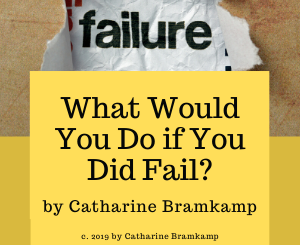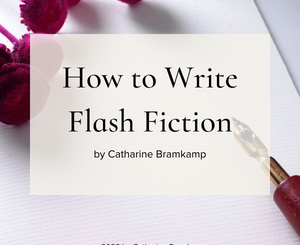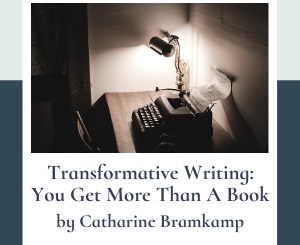The Best Way to Deliver Your Message: Message in a Bottle (Your Story) by Catharine Bramkamp
 Let’s welcome back monthly columnist Catharine Bramkamp as she shares with us “The Best Way to Deliver Your Message: Message in a Bottle (Your Story).” Enjoy!
Let’s welcome back monthly columnist Catharine Bramkamp as she shares with us “The Best Way to Deliver Your Message: Message in a Bottle (Your Story).” Enjoy!
***
What is the best way to deliver your powerful message or warning?
You know the answer — through story.
But how to deliver an important message is a more difficult question to answer.
Myths and legends are powerful and ubiquitous for a reason – they tap into and illuminate our basic human needs and unconscious desires and bring them to light through story.
The Easy Path
Some authors take the easy path — they drop their opinions into the mouths of a character.
This is not without problems.
For example, let’s say you are writing a genre western. In the middle of the bank heist, gang member 3 stops the action to deliver a rant on the effects of explosives on air quality. The other two gang members may be impressed by his insights, but the reader is not.
Yes, the author wants to make a point. But tossing in a rant about the environment from the mouths of gun slinging bandits is not only awkward, it invites the reader to skip ahead.
Yeah, yeah, yeah, but will the explosive work? Will they get caught?
Is there a better way to deliver your important message? A better approach?
There is but it is more involved and requires more effort: weave your message — often the theme of the story — into the story structure itself.
The Harder, but Better, Way
Create a hero’s journey that, through metaphor, allegory, or symbolism, is expressed dramatically as part of the story.
Allegory: a story, poem, or picture that can be interpreted to reveal a hidden meaning, typically a moral or political one.
Using our Western bank robbers, maybe one of the gang members deeply cares about the environment. So he encourages his friends to pick up their trash, put out the campfire, and, ultimately, that caution will save the day.
Archetypes and Myth
You are probably familiar with the uses of archetypes and myth as a frame for your story.
Myths and legends are powerful and ubiquitous for a reason — they tap into and illuminate our basic human needs and unconscious desires and bring them to light through story.
We as authors use this common frame of myths and legends to deepen our stories and connect with our readers and, best case, embed new ideas without sounding preachy.
The framework common to myths is:
- Ordinary World
- Call to Adventure
- Refuse the Call
- Mentor appears and encourages
- Cross the first Threshold
- Tests – Allies and Enemies
- Approach the Innermost Cave
- Ordeal
- Reward
- Road back
- Resurrection
- Return to the Ordinary World with Elixir
[Editor’s Note: this framework is based on the work of Christopher Vogler, The Writer’s Journey: Mythic Structure for Writers, which is based on the work of Joseph Campbell, The Hero with a Thousand Faces]
I am confident that as soon as you read the breakdown, you recognized the basic structure of every story from Gilgamesh to The Odyssey to Star Wars.
Putting Allegory to Work
One of my clients is reasonably concerned with climate change and the increased use of dangerous chemicals in food, particularly children’s food.
Instead of preaching about her concerns, she wrote a novel that wove the past with the future. She switched from TELLING us about how dangerous big pharma is to SHOWING a dystopic future with fewer and fewer surviving children.
Going Deeper
Using the big theme of climate change here is a possible set up from Heartwood by my friend Shirley Dickard:
Ordinary World
Here is the hero doing what she always does, the reader may see the consequences, but she usually does not.
Call to Adventure
The error of her habits are called out to her.
Refuse the Call
She ignores the errors and resents this new information because everything is fine. Perhaps she just invested her entire portfolio into a big pharma company — think Margaret Atwood’s Maddaddam Trilogy.
Mentor appears and encourages
The heroine meets up with a poisoned child and suddenly becomes involved, not in the big picture but in a small, singular act of salvation.
Cross the first Threshold
She leaves her home to track down the cause of the child’s discomfort or illness.
Tests
Allies and Enemies — for instance, she encounters indifferent bureaucracy, best illustrated in the form of a repulsive individual.
Approach the Innermost Cave
She finds a solution, but it is dangerous, perhaps impossible.
Ordeal
The impossible engulfs her, raining down everything from insults to personal danger.
Reward
She wins and is granted the change she seeks, but the villain is the CEO of the very company she has invested in.
Road back
She chooses life over profit, but the child is still unwell, she must perform one more gesture.
Resurrection
She is changed by the experience. She believes. She advocates. She finds herself in her new understanding of the world and what should happen.
Return to the Ordinary World with Elixir
She returns to the child with the plan for recovery, empowers her tribe for further action against the big pharma company (like Erin Brockovich) and our heroine now offers a way to make needed changes.
Final Outcome
She saves the child, she saves the world.
Ultimately
We read for change, we read to understand.
When we follow a hero or heroine through their trials, we can change as well. Which is why, when a fictional story taps into the universal, the author can deliver a new, important message using the most effective way we have: art.
Heart Wood by Shirley Dickard.
***
Want to read more articles like this one Writer’s Fun Zone? Subscribe here.
***
ABOUT THE AUTHOR
 Catharine Bramkamp is a successful writing coach, Chief Storytelling Officer, former co-producer of Newbie Writers Podcast, and author of a dozen books including the Real Estate Diva Mysteries series, and The Future Girls series. She holds two degrees in English and is an adjunct university professor. After fracturing her wrist, she has figured out there is very little she is able to do with one hand tied behind her back.
Catharine Bramkamp is a successful writing coach, Chief Storytelling Officer, former co-producer of Newbie Writers Podcast, and author of a dozen books including the Real Estate Diva Mysteries series, and The Future Girls series. She holds two degrees in English and is an adjunct university professor. After fracturing her wrist, she has figured out there is very little she is able to do with one hand tied behind her back.
Also by Catharine Bramkamp
https://writersfunzone.com/blog/2022/03/08/showing-off-by-catharine-bramkamp
https://writersfunzone.com/blog/2022/02/01/is-visualization-the-key-to-success-by-catharine-bramkamp
https://writersfunzone.com/blog/2022/01/07/creativity-how-to-get-more-by-catharine-bramkamp






